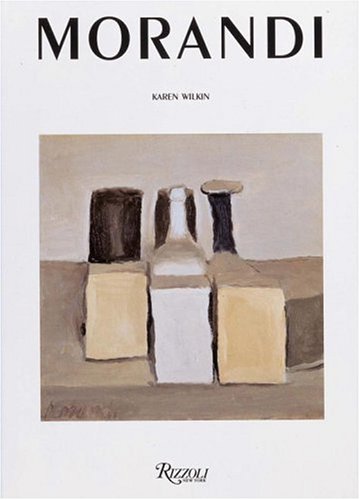A couple of months ago, I hung a poster over my front door, a reproduction of a still life consisting of three boxes, a cup, and a jug, all floating in a neutral-colored void. The painter’s name appears nowhere on the poster, which came from a still-life show at Washington’s Phillips Collection, my favorite museum. Ever since I put it up, at least one visitor per week has asked me who did the painting. You wouldn’t think so plain an image would attract so much attention–I have far more eye-catching items on my walls–but there’s something about it that speaks to a certain kind of person.
 Not to keep you in suspense, but the painting in question is a 1953 oil by Giorgio Morandi called, simply, “Still Life.” Most of Morandi’s paintings are called “Still Life.” He was born in Bologna, Italy, in 1890, and died there in 1964, and he spent most of his seemingly uneventful life arranging and rearranging a dozen or so boxes, cups, jugs, bottles, and pitchers on a tabletop, and painting them over and over again. Sometimes he made etchings of his carefully arranged objects, and from time to time he painted a landscape. That’s about all there is to say about him, really, except that he was a very great artist, which is more than enough to say about anybody.
Not to keep you in suspense, but the painting in question is a 1953 oil by Giorgio Morandi called, simply, “Still Life.” Most of Morandi’s paintings are called “Still Life.” He was born in Bologna, Italy, in 1890, and died there in 1964, and he spent most of his seemingly uneventful life arranging and rearranging a dozen or so boxes, cups, jugs, bottles, and pitchers on a tabletop, and painting them over and over again. Sometimes he made etchings of his carefully arranged objects, and from time to time he painted a landscape. That’s about all there is to say about him, really, except that he was a very great artist, which is more than enough to say about anybody.
What makes Giorgio Morandi’s paintings so special? To begin with, most people don’t seem to find them so. Though Morandi is renowned in his native Italy, he is unknown in this country save to critics, collectors, and connoisseurs. It’s easy to see why. His art is too quiet and unshowy, too determinedly unfashionable, to draw crowds. It creates its own silence. “Curiously, these deceptively modest paintings, drawings, and prints seem to elicit only two responses: extreme enthusiasm or near-indifference. And yet, this is not surprising, since Morandi’s art makes no effort to be ingratiating or to put itself forward in any way….For anyone who pays attention, the microcosm of Morandi’s tabletop world becomes vast, the space between objects immense, pregnant, and expressive.”
That quote is from Karen Wilkin’s Giorgio Morandi. Wilkin is one of America’s finest art critics (as well as a damned good freelance curator), and her profusely illustrated monograph makes the case for Morandi far better than I could ever hope to do. What I wish I could do is tell you to go right out today and look at a dozen Morandis, but you can’t, unless you happen to live in Bologna, in which case you can go to the Museo Morandi and look at them to your heart’s content. Most major American museums in America own a Morandi or two, and sometimes they even hang them. The Phillips often has one of its two oils on display, and in recent months I’ve seen Morandis in Princeton and St. Louis. But I’ve never seen one in New York, except for the reproduction in my living room. Somebody in this country is collecting them–Morandi’s etchings are way out of my modest price range–but it clearly isn’t MoMA or the Metropolitan Museum of Art.
Barring a quick side trip to Bologna or Washington, your best bet is to purchase a copy of Giorgio Morandi. I’ve given away several copies as presents. Only last week, I gave one to a friend who noticed my Morandi poster and asked about it. Should that ring the bell, you can buy a poster of your own. You will then be officially enrolled in the International Society of Morandi Fanatics. We don’t have meetings–we just trade occasional e-mails about what’s hanging where. Feel free to advise me about domestic Morandi sightings. And if any of my wealthy readers are feeling moderately generous, a gift of a Morandi still-life etching would not go unappreciated.
